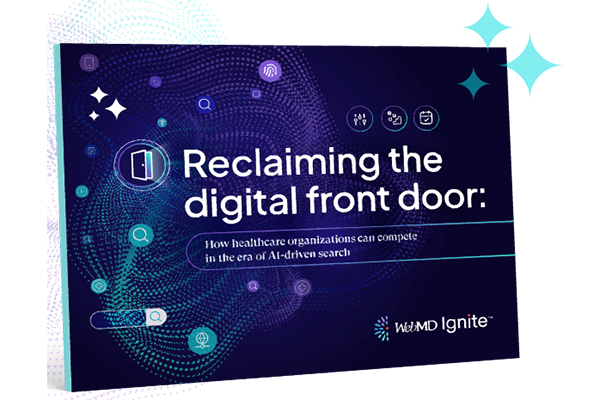Calculating the Total Cost of Ownership for Healthcare Software

Categories: health plans, health systems, healthcare organizations, associations
Editor's Note: This blog was published prior to the transition to WebMD Ignite.
With the advent of the digital age, consumers have increasingly turned to the Internet as their primary source to support decisions regarding medical care and provider selection. As a result, modern healthcare marketing tactics have become heavily digitized – and data underlies the entire operation, from patient demographic data to campaign performance data, to market claims data, to engagement metrics, and so forth. All of this is to say: Without the right software and technology in place to consolidate, interpret, and analyze data, even the most creative patient acquisition and retention tactics will fail.
These days, robust healthcare software is nothing short of mandatory. An HCRM, for instance, allows health systems to integrate data from multiple sources and create comprehensive customer profiles, tracking interactions with patients and consumers across channels to obtain a 360-degree view of activity, preferences, and tendencies. It serves as the technological foundation for effective, personalized marketing communications: Messages delivered to the right people, over the right channels, at exactly the right time.
Understanding your options for healthcare software solutions
Whether you’re thinking about investing in a patient acquisition and retention platform or referral intelligence software for the first time or you’re researching alternatives to existing (perhaps underperforming) platforms such as those used in the contact center, it’s critical to spend time carefully weighing your options.
There are a variety of choices available on the market, ranging from system integrators (SI) that custom-build/configure on top of an existing platform to pre-built, ‘turnkey’ solutions. Performing a total cost of ownership (TCO) analysis helps accurately compare options, ensuring you’re not only thinking about up-front costs, but also consider expenses involved with the long-term partnership.
In this post, we’ll explain the purpose of TCO analysis, point out key considerations to keep in mind, and introduce best practices for anyone researching or planning to invest in healthcare software.
What is total cost of ownership (TCO)?
TCO is “the purchase price of an asset plus the costs of operation” or, in other words, the sum of all direct and indirect costs incurred. TCO is often used alongside ROI calculation when initiating a project, and takes into consideration expenses involved with implementation, upkeep, support, compliance, and many other factors.
When evaluating healthcare technology, TCO analysis should be a necessary step to your research and comparison-shopping process. As we know, software is not a static resource – it is dynamic, requiring ongoing assessments, adaptations, and upgrades in order to provide the maximum value for its users. All of this can add up quickly, and it’s easy to miss hidden costs or expenditures without thinking at least 2, 5, or 10 years down the road.
Key considerations when evaluating healthcare software TCO
In general, there are three key categories of cost that go into a comprehensive TCO analysis for healthcare software. These are:
Acquisition Costs
These include the cost of the software(s) itself, usually either billed hourly for custom projects or offered at a fixed-fee delivery for out-of-the-box (pre-built) solutions. Acquisition may involve hardware costs, when applicable – though this is typically not a factor for cloud-based solutions. It also includes:
- Implementation costs
- Up-front user licensing costs
- Any requested customizations
- Assembly (Higher for a software investment, lower for a ‘Solution’)
- Data migration
- Acquisition of third-party data
- Training
- Data exchange (if third-party systems need to be integrated)
Operational Costs:
During the course of the software’s lifetime, you’ll likely incur costs involved with:
- Yearly subscription fee (when applicable)
- Maintenance and upkeep
- Acquisition of additional user licenses
- Accessing user support and resources
- Security and bug-fix patches
- Upgrades and enhancements
- Ongoing data governance
It’s also smart to consider the cost of a secured hosting infrastructure for data storage in a protected, HIPAA-compliant environment – as well as eventual retirement costs, including archiving and data export.
Resources (Personnel) Costs
In many cases, health systems need to hire or re-allocate employees to support the software implementation process and ongoing partnership with the vendor. It may not be necessary to permanently restructure your team – however, expect to adjust staffing for at least 6 months to a year in order to provide adequate support. Some healthcare software providers recommend an internal staffing plan specifically for the implementation phase.
When potential customers come to us with questions about hiring the right internal resources for CRM implementation, as an example, we recommend the following:
- Identify a project sponsor to define the objectives and measurable targets
- Tap a project manager to coordinate meetings and trainings on the client side
- Find key subject matter experts and technical resources
- Understand who the Super Users will be: These key users will become the points of contact around product adoption and will be trained as System Admins
The same person can cover multiple roles within the implementation process, but it’s important to set clear lines of responsibility not just for your team but also your vendor partner. Having these lines of accountability articulated will help get the most value from the software.
If you are thinking about restructuring your marketing team as you adopt new strategies and technology, Rachel Neely recently presented on the ideal marketing team structure as part of a series.
TCO formula for healthcare software
To calculate total cost of ownership for healthcare software, simply combine the above components using the following formula:
TCO = [(OC + RC) x Y] + AC
Where:
- OC = Operational Costs (per year)
- RC = Resources Costs (per year)
- Y = Years of Ownership (estimated)
- AC = Acquisition Costs
Selecting the right healthcare software: build vs. buy
The evolution of healthcare requires a litany of analytic insights, integration, and engagement technologies. It’s important to decide early on if you want to take on the challenges of assembling these layers, or if you want to invest in a solution that’s built to flex and scale with your needs and use cases. While initial cost of a ‘solution’ investment may be higher, there are time-to-value, longer term cost of ownership, and technical resource availability considerations to factor into the decision.
When health systems begin the comparison process for marketing software or HCRM solutions, physician relationship management tools, or contact center software, they discover both pre-built, out-of-the-box solutions that have already been customized to fulfill the industry needs – as well as services integrators that build a solution from scratch, sometimes partnering with a non-industry-specific CRM as their basis. Both options have their benefits and drawbacks; however, the TCO analysis between the two may look dramatically different.
“Build” model
In a “build” model, one of the key TCO challenges has to do with scope. The baseline platform (for instance, Salesforce Health Cloud) needs additional configuration. Features such as a HIPAA-compliance, integrations to the EMR and other key technologies, and access to third-party data will need to be incorporated from scratch – meaning that a quote for the cost of implementation from an SI is nothing more than a rough estimate, and implementation itself may take up to a year or more.
System integrators typically charge for “time and materials” for each requirement or feature they build, contributing to cost overrun. Meaning, beyond an initial implementation, clients often find themselves having to go back to the SI for additional work as they grow and evolve in their use cases.
Each time this occurs, those teams are starting from the beginning to gather requirements and complete the necessary coding. Or, said another way: Ongoing innovation and technology enhancements are not included, but rather carry a price tag. Finally, when the base technology is updated, it has the potential to break workflows and configurations, forcing you to bring the SI back in (at an additional cost) to resolve the issue.
“Buy” model
While pre-built, configurable software may require an annual fee, the yearly cost is diminished vis a vis the lack of costly billable hours during the implementation phase. Similarly, ongoing maintenance costs – including the costs to maintain compliance via upgrades and migrations – tend to be reduced with pre-built software since that’s in part what your annual subscription fee covers. In a Buy model, regular solution upgrades, enhancements, and ongoing innovation are more likely to be included in the annual fee.
Data integration capabilities should also be factored into the TCO equation. In order for marketing teams to create and launch successful precision marketing campaigns or contact center agents to proactively provide great service that guides the caller to the best care option, health systems need to match, merge, and de-dupe data (like consumer, household, patient, and claims data).
There’s also the investment in the market data (consumer, household, and claims data). It can be prohibitively expensive to acquire these data feeds directly; however, in a Buy scenario, the vendor partner has typically made the investment at scale and those savings are passed down to the buyer. But having access to the data isn’t the only part of the equation: It’s what happens next that truly matters.
In a market share growth use case, applying machine learning and AI to understand market demands, ideal consumer audience segments, etc. are built by the solution partner. You immediately gain the benefit of their experience and expertise that comes from working across a larger group of organizations. However, in the Build scenario, you are left not only to purchase the data directly, but also to spend time and resources creating similar analytics.
Key takeaways
Whether you’re in the market for an HCRM, contact center technology, PRM, a marketing automation tool, or other healthcare software solution, it’s important to remember that your investment goes beyond just the purchase price of the software. Think of your relationship with your software or solution provider as a partnership: A mutually beneficial exchange that encourages shared learning and remains open and transparent around change management, strategy, and cost.
Keep in mind that a partnership will ideally last for years, so you want to be sure that the software or solution you choose is flexible enough to suit your organization’s rapidly changing goals.
To set the stage for a valuable partnership, health systems should approach total cost of ownership analyses with great care. Hidden costs are rampant – especially when it comes to long-term software upkeep. Ultimately, pre-built healthcare software tends to be priced more transparently, has a shorter configuration cycle, and minimizes billable hours associated with customization. This, in turn, maximizes speed-to-value and overall ROI.




